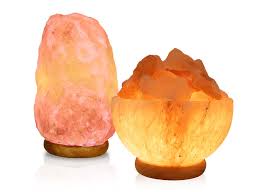Salt Lamps. You see them everywhere now, but do you have one in your house? What are the advantages to having one, what size do you need, and are they really effective? We have been doing some research and have found some amazing and interesting facts about a salt lamps function and usability.
Most salt lamps on the market come from the Himalayan Mountains and are carved right out of the massive salt deposits found there. They come in all sizes and shapes. We see them white, yellow, orange. Some people think that the darker the better, but as Salt Lamp effectiveness goes, there is not much difference. The action or usefulness of salt lamps comes from the salts ability to produce negative ions. These ions are produced when salt (NaCl) comes in contact with water and heat. As the salt heats up and absorbs water, it evaporates adding water and negative ions back into the air.
There are many pollutants floating around in our air. Many of these are positive ions, like carbon dioxide, that has lost an electron. These charged molecules in your home can lead to poor health if not eradicated. Research has found that even your HVAC system (heat pump) produces tons of positive ions during the process of heating and cooling your home. “Sick Building Syndrome” is a state of poor health and depression that is seen often in large communal buildings and high rise apartments. This sickness is thought to be a result of all of the positive ions being produced by heating and cooling of the building. What can we do to clear these pollutants? Filters can clear a lot of the particulate matter in the air, but you need to add negative ions to finish the job.
Have you ever noticed how clean the air feels after a storm? Ever wonder why the ocean breeze always feels fresh? Water interaction with heat (lightening) and salt (ocean) produces negative ions which clear the air naturally! This is what a salt lamp can bring to your home or place of business. Salt lamps slowly absorb water from the atmosphere. By heating them up with an incandescent bulb, you can recreate the natural reaction to release negative ions into your room! Negative ions with absorb positive ions and leave the air cleaner and fresher. But what size do you need to do the job? A good rule of thumb is to have a 1 kilogram lamp for every 10 square meters of space in the room. In real life terms that means:
2-4kg lamp – 20 – 40sqm – A workstation or small treatment room
4-6kg lamp – 40 – 60sqm – A small bedroom or standard office
6-8kg lamp – 60 – 80sqm – A small living area or medium sized bedroom
10-13kg lamp – 100 – 130sqm – An average sized living area or large bedroom
13-16kg lamp – 130 – 160sqm – A medium sized entertainment area or meeting room
16-20kg lamp – 160 – 200sqm – An average sized open plan office
20-25kg lamp – 200 – 250sqm – A large living area or a small to medium cafe or restaurant
25-30kg lamp – 250 – 300sqm – A very large open plan home or office
For those of us here in the US a kg is equal to 2.2 lbs
The usefulness of salt lamps is well documented. Most experts suggest having at least one lamp in every room of your home that is artificially heated or cooled. Leave them on as much as possible. They only produce negative ions when being heated, and if they cool they can “sweat,” leaving a salty puddle around the base. If you are in the store, check out our great values on our lamps.

